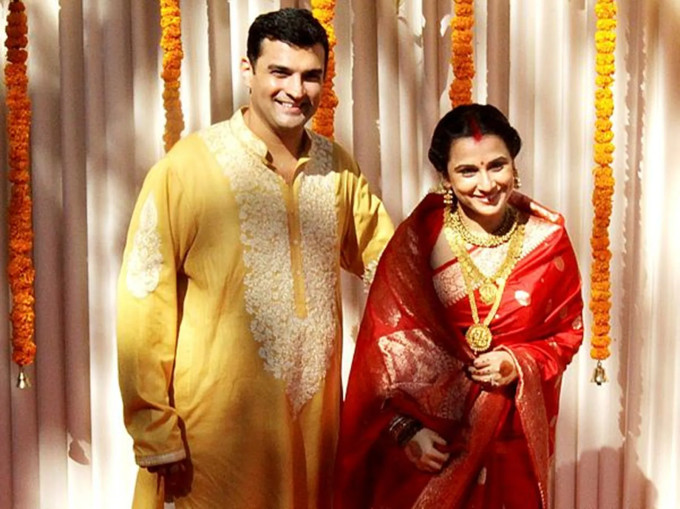Vidya Balan likens herself to a boat in her relationship with Siddharth Roy Kapur; what does the ‘boat anchor theory’ say about your bond?
In a recent podcast with content creator Raj Shamani, actor Vidya Balan likened herself to a “boat” in her marriage with Siddharth Roy Kapur, when asked whether she considers herself as a boat or an anchor.
Shamani said, “There’s this study where they say that you can randomly ask people who are in relationships about – are they boat or an anchor – and their first instinct will tell you the person they are and who they’re attracted to.”

“If you are a boat and you have great relationships, it means the other person in your life is an anchor.”
Initially, Balan said, “It depends on what the other (person) brings out in me.” But, after being prompted to choose one, she admitted that she likes to “go with the flow” as she is more adventurous compared to Kapur, who she says, is the rock or the anchor in the relationship and “a very calm and zen person.”. “He’s the rock, he’s solid for all the people in his life… not just for me, but his own family, his friends… so he’s just one of those people,” she elaborates.
The boat and anchor theory is an analogy often used to describe the roles individuals play in relationships. The boat represents the partner who brings excitement, adventure, and movement to the relationship, while the anchor symbolises stability, support, and grounding.
Application of the ‘boat and anchor theory’ to partnerships
Mental health and relationship expert Aashmeen Munjaal expressed that generally, the boat represents the partner who goes with the flow and brings in energy and drive in a relationship, whereas being an anchor significantly brings in the qualities of stability and support.
“Just as an anchor keeps the boat steady in high tides, in marriages too anchors act as a source of support and security in challenging times. On the contrary, a partner with boat qualities may be more adventurous, injecting excitement into a relationship.
However, she adds that it is not necessarily the case that one partner remains the boat and the other remains the anchor. “With changing circumstances, there can always be a change in dynamics. You must remember that to maintain a healthy relationship, you must foster effective communication, respect, compassion, and understanding with each other.”
In the context of marriage, Rhea Joseph, consultant psychologist at Cadabams Mindtalks adds, this theory highlights the balance of stability and growth within the partnership. A healthy marriage often requires both these elements – adventure to keep the relationship vibrant and growth-oriented, and stability to ensure safety and trust.
 Vidya Balan says that her husband Siddharth Roy Kapoor is the rock for everyone in his life. (Source: Express archive by Pradip Das)
Vidya Balan says that her husband Siddharth Roy Kapoor is the rock for everyone in his life. (Source: Express archive by Pradip Das)
Roles of the boat and the anchor in relationships
Joseph describes what the role of a boat and an anchor means in relationships:
Boat’s Role: The boat in a relationship is about forward motion and adaptability. This partner often drives change and encourages the couple to try new experiences, facilitating personal and mutual growth.
Anchor’s Role: The anchor provides a sense of safety, reliability, and consistency. This role is crucial for building a secure base in the relationship, from which both partners can confidently explore individual and shared aspirations.
Balancing Roles: Understanding and appreciating these roles can lead to a more harmonious relationship. Partners can switch roles as needed, adapting to life’s changes and challenges, ensuring that both growth and stability are nurtured.
How Balan realised that Kapur is ‘the one’ for her: Significance of small gestures
Balan’s close and loving relationship with her husband sheds light on the dynamics of their relationship. She recalled a moment when Kapur went out of his way to fulfill her simple desire for a cup of coffee. “It was late in the night,” she recalled that she had just arrived at the airport and he came to pick her up.
But, since she wanted to have some coffee, he decided to brave the heavy rain by finding a restaurant that was still open and fetching her a cup of her favourite beverage. “As he was walking away from me, I said I was home. I don’t know why I felt that.” she said.
Munjaal says that this reveals a lot about the nature of romantic connections and the significance of small gestures in building intimacy.
“The actress’s experience indeed reflects the concept of emotional bonding within a romantic relationship. This gesture highlights care, compassion, and thoughtfulness towards her needs. Such small gestures foster a sense of security and comfort in any relationship.”
Joseph also notes, “Consistent small gestures like these can be more impactful than occasional grand gestures. They build a cumulative sense of being valued and loved, which is crucial for deep, enduring connections.”
Such actions often hold symbolic meanings, serving as tangible manifestations of love and support. They reassure individuals of their partner’s commitment and understanding, she says, which are foundational to romantic satisfaction.
Disclaimer: The copyright of this article belongs to the original author. Reposting this article is solely for the purpose of information dissemination and does not constitute any investment advice. If there is any infringement, please contact us immediately. We will make corrections or deletions as necessary. Thank you.
